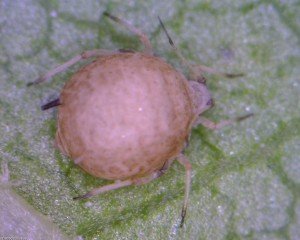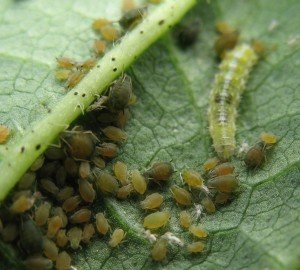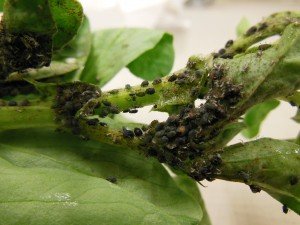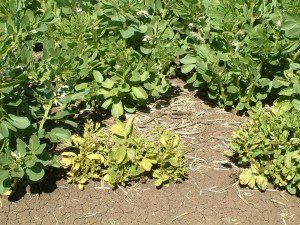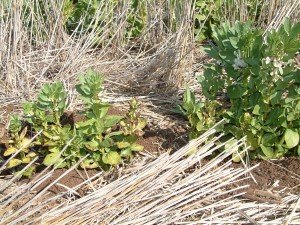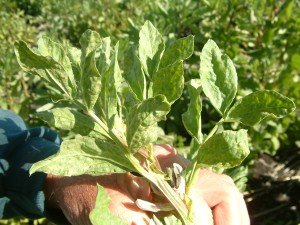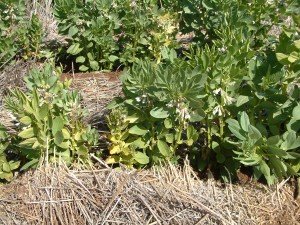As the warm weather persists, insect activity is remaining high. DAFFQ Entomology has received numerous reports of aphids, and leaf-feeding caterpillars.
The aphids have been identified as cowpea aphid and the caterpillars as one of the summer-active armyworm species, Spodoptera exigua (lesser armyworm). The concerns about these are for the potential for crop loss caused by direct feeding damage/defoliation or virus transmission by the aphids.
Armyworm caterpillars
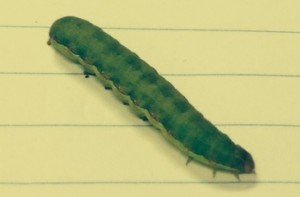
Large lesser armyworm larva (Spodoptera exigua) from faba beans. Photo: Chris Teague.
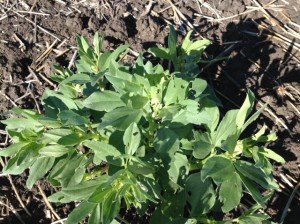
Spodoptera damage to faba beans – leaf feeding. Photo: Chris Teague.
The armyworm are leaf feeders, similar to the cluster caterpillar (S. litura) that attacks cotton, and the dayfeeding armyworm (S. exempta) that defoliated late maize and sorghum crops in summer.
Although no work has been done directly on this species, or on the impact of defoliation on faba bean, we can extrapolate from what we know about other defoliating species to guide decisions. The reports from the Goondiwindi and Moree areas suggest that 2 to 3 larvae per plant are causing less than 10% leaf loss on late vegetative faba bean plants. In soybeans, the defoliation threshold for helicoverpa is 33%, a point beyond which the plant cannot compensate.
The armyworm will complete their development and pupate in the soil. The pupae will remain in the soil and emerge in spring. It is unknown whether they will re-infest the same faba bean crops, but it is more likely that the moths will disperse from these fields.
Cowpea aphid
Cowpea aphid appears to be the dominant species in faba beans at present, although there may be a smaller number of blue-green and pea aphid in the crops. The risk of crop damage caused by direct feeding of aphids is low, particularly as the populations seem to be in decline in crops where they have been present for 2 to 3 weeks. In rapidly growing crops it is unlikely that colonies of aphids will impair crop growth. In rarer instances, very heavy infestations may occur that will slow crop growth and flowering. In autumn we expect to see high natural enemy activity with carryover of the predators (ladybeetles, hoverflies, lacewings, predatory bugs) and parasitoid wasps from summer crops. Where aphid populations are in decline, there is clear evidence of parasitism and predation.
Look for natural enemies when you are checking aphid infestations. Whilst natural enemies won’t prevent virus transmission, they will contribute to minimising aphid survival and spread (and consequently virus spread) within the field.
Also take notice of the pattern of aphid infestation in a field. Is it confined to the field margins, or is it more widespread across the field, perhaps originating from broadleaf weeds that have hosted aphids in late summer, early autumn? Be aware of possible sources of aphids and viruses nearby e.g. weedy summer crop, weedy fallows, lucerne. These factors are relevant to virus risk and how you might most effectively implement control.
As the weather cools, the aphid population growth will slow. Whether the aphid populations die out completely during winter, or survive at low levels to build again in spring is unknown.
Aphids as vectors of virus in faba beans
Bean leafroll virus (BLRV) and Bean yellow mosaic virus (BYMV), Soybean dwarf virus (SbDV) and Subterranean clover stunt virus (SCSV) are the most commonly recorded viruses in faba beans. In the field, symptoms of these viruses look very similar and the only sure way to distinguish them is with antibodies or molecular tools. SCSV is not very common, the only recorded incidence was a heavy infection in 2003. However, we might see it this year as its main vector is cowpea aphid. The main vector for BLRV and SbDV is the pea aphid (but BLRV might also be transmitted by cowpea aphid). BYMV is non-persistently transmitted and can therefore be transmitted by a range of vectors.
All these viruses can cause significant yield losses if infection occurs during the seedling stages and BLRV can still have a major impact with spring infections.
PBA Warda has higher level of tolerance to BLRV than older varieties, but is not completely resistant.
It is important to remember that not every aphid that lands in a faba bean crop is necessarily carrying virus. Virus symptoms will appear in crops around 10 to14 days after infection. BLRV symptoms are upward rolling of leaves and interveinal yellowing of older leaves. Symptoms of BYMV are typically vein yellowing and green-yellow mosaic veins.
Once faba bean plants are infected with virus, they will remain infected. Plants infected in autumn become sources of virus in spring, although (depending on the virus) the impact of the virus on yield will be lower if infection occurs in a later stage of crop development. In-crop aphid management becomes more important in paddocks where autumn virus infections have taken place.
Some regions are known to be high risk virus areas, e.g. Liverpool Plains. Little is known about the relative risk of virus in other regions.
Some factors that increase virus risk in a region are: i) regular rainfall that promotes the growth of weed hosts on which the aphids can build up before moving into crops; ii) weed or crop virus reservoirs e.g. Lucerne, legume pasture, brassica weeds.
Management of aphids
The conventional wisdom is that if aphids can be readily seen in the crop, then they will have already transmitted virus (if they are going to) and there is no benefit in controlling them, the damage is done. This scenario is probably true in an autumn when the aphid infestation is halted by cool weather. However, with the extended period of mild weather this autumn, there is the potential for aphids to colonise bean crops and then continue to infest more widely in the crop. If these aphids are carrying virus, this scenario will result in more widespread virus infection in the crop, with implications for yield and further infection in spring.
The benefits of controlling aphids to prevent direct damage (feeding damage) is not well understood. The current thinking is that the impact of direct feeding has little impact on yield, and is unwarranted unless aphid infestations are extreme.
Thanks to Joop van Leur (NSW DPI) for information on viruses and aphid vectors and photographs of virus symptoms.
For more information on managing virus and other diseases in faba beans see the Pulse Australia website for the Disease management in faba beans factsheet and the Management of pulse viruses factsheet.


